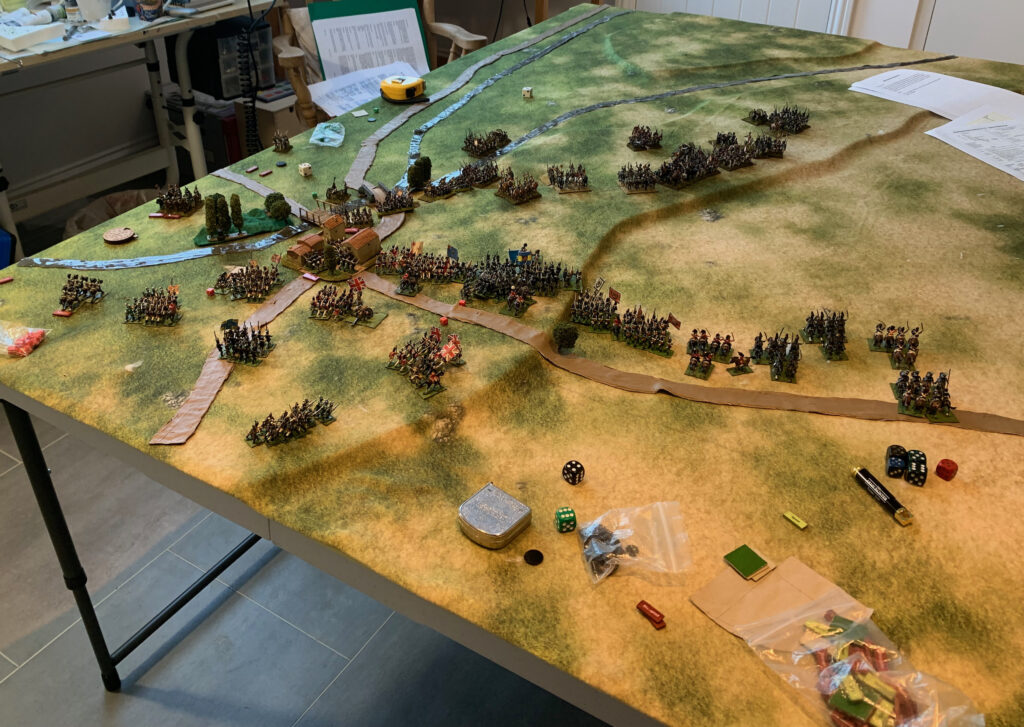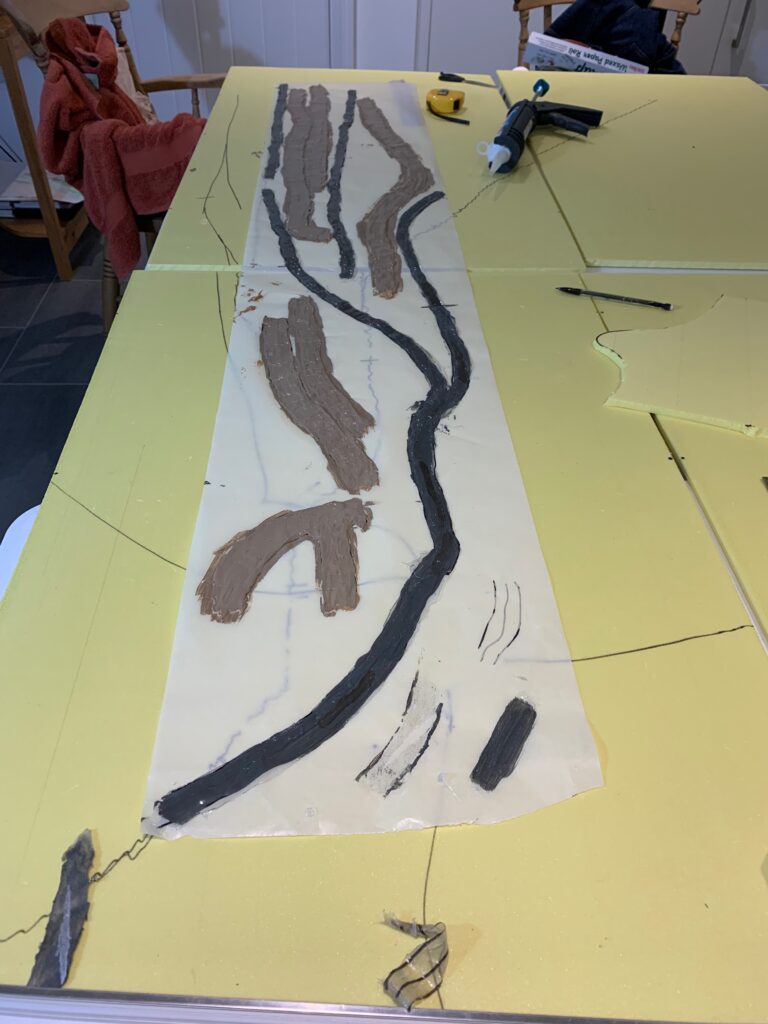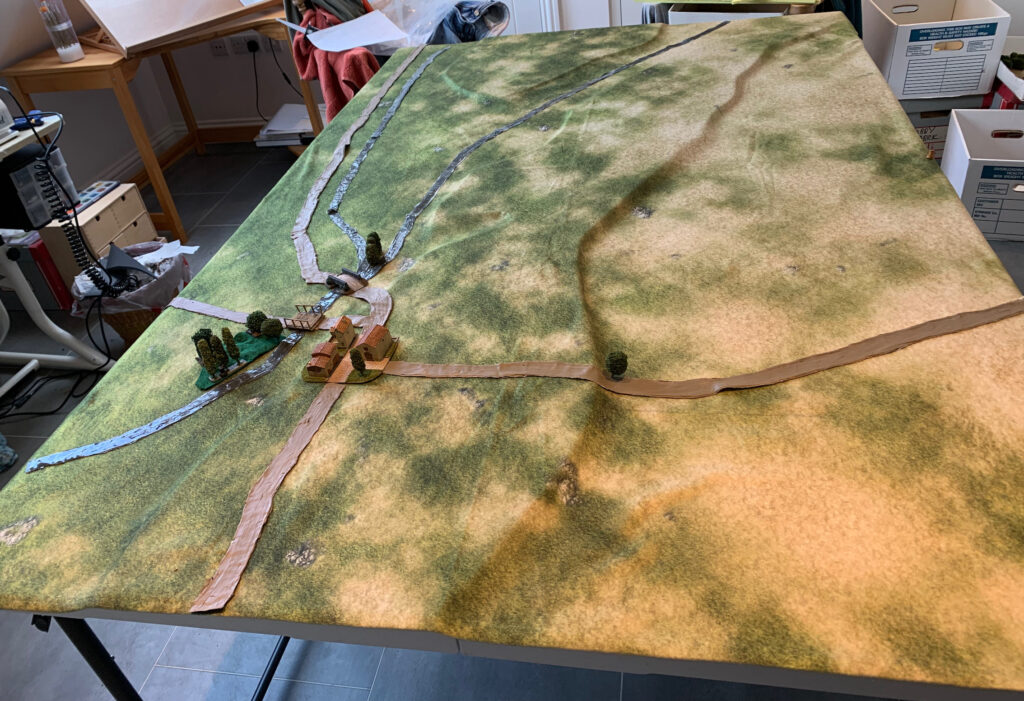
At last another game, as my friend Rob was kind enough to visit! I had to put together a scenario quite quickly – and one that could use Rob’s British and allied Minifigs. I decided on Albuera 1811. It is a battle I know quite well, has plenty of action, and the terrain is relatively straightforward.
I have used this as a scenario at a club game using my big battle rules – but I was concerned that this would not be a big enough game for up to five hours of table time. So I decided to scale down (or up?) the rules to halve my normal figure ratio, so that the main units were brigades rather than divisions. Each infantry base was 600 infantry, 200 cavalry or 8 guns. I have just bought Sam Mustafa’s Lasalle rules, and funnily enough each base corresponds to one the standard-sized units in that ruleset. The only adjustment I made to game play was to extend the artillery bombardment ranges by 3 inches. Developing a version of the rules at this scale is certainly something I want to do, but at this stage I am not thinking too hard about what other changes might be needed. The ground scale is 75% of normal, so that each inch is 112.5m, or 150 paces in contemporary military measurement – over 14 inches to the mile compared to under 11. This meant interpreting the 50% figure ratio as relating to footprint rather than frontage.
The game starts at 8am. The French are lined up along the road from Seville that you can see on the left-hand side of the table. The allies are behind the village, with three units off the table on their way. There is a lot of empty space on the top right of the table. As I was setting up the game I realised that I had made a mistake in my previous versions of the game: the road from Badajoz is the one disappearing off the bottom table edge, rather than the one going off to the right. This is the critical campaign axis and the French objective, and the route along which allied reinforcements were coming. If I had appreciated that I would have shifted the table one foot up to have more space along this road, and less at the under-used far end. That would have crimped the French deployment, but that is surely not a fatal problem.
I chose the set-up because I wanted to give the French player the choice of carrying out the historical flank attack, or of something much more frontal, which tends to be the way the French player goes when I run it as a club game. The problem is that if the French do opt for the flank option, as I did this time, the allies have too much time to reorganise. I tried to give the French a head start, with a free move at the start, though one they couldn’t use to mount an attack, as well as the first move in the next turn. Though the French manoeuvred with impressive speed, the allies had little difficulty in repositioning their army to face the threat though. In practice I think the Spanish allies were harder to move around than they were in this game, when I gave them a -1 on the Activation throw. But there may also be a problem with the battle account that I have been following. The French main army may have deployed from the road before 8am – which was when the firing started.
The first few moves were taken up with manoeuvring, and some skirmishing around the village. These early exchanges did not go well for the French, so I did not press them. The photo shows the situation as the allies more or less completed their repositioning, after about two or three moves. After this the French continued their turning manoeuvre, led by the cavalry, and assembled the artillery in a grand battery. As historically, but in a different position on the field, Zayas’s Spaniards took the first brunt, and were pushed back. The grand battery (not a historical tactic in this battle) successfully caused consternation among Ballesteros’s Spaniards (there were some bad throws), and forced it out of the line. But the British troops plugged the gap, and weathered the artillery without difficulty. The game ended with the French hurling their infantry forward across the line into British and Portuguese troops; I needed some lucky dice, which were not forthcoming. By now it was 5pm, we were tired, our wives were back from a day’s exploring the shops in Lewes, and we called it a day. Here is the situation:

The Allied line has been bent right back, but the French would have to be very lucky to push the British troops back much further. Some units were looking a little worn, but remarkably few had been knocked out of play (the British heavy dragoons may have been the only one). We had played about 9 turns in roughly four hours. The game had started an hour late because of a navigation mishap by my guest.
The scenario clearly needs more work, but it makes for a good game – even if difficult for the French to win. As the French player I probably needed to get stuck in more quickly with the infantry while the cavalry tried to pressure he flank. Unfortunately there does not seem to be a good way to bypass the Spanish troops so the French run the risk of wearing themselves out on the poor troops before taking on the good ones.
How about the rules? This was a very good test of game play, as all arms got a good look-in and there was opportunity for manoeuvre. More work is needed, unfortunately. The good news as that they played quite quickly, but the combat needs to be more decisive. The armies need to be crumbling at the stage we ended the game. The ability to recover from one or two disruptions may be the issue, rather than the rate at which disruptions are handed out. My new rule mechanism for “pinning” – causing the responding side to “borrow” moves from its following turn – proved a damp squib. I also think the combat and casualty mechanisms need to be more intuitive. Command and control also needs more thought. While the French army moved fast enough, the allied army had it too easy, even with not very strong command resources. The game needs to move a little closer to the “PIP” system where the action follows from command focus, which can’t be across the field. It is probably too easy to get two or three actions on the activation throw without intervention from senior command – but probably OK for one action. One idea that did work was limiting artillery to six shots – this made players think more carefully about how to use guns, and limited the temptation to keep blasting away forever.
I will be thinking hard about revisions to the rules – which also need to be a bit clearer in places. What a long journey rule-writing can be!



